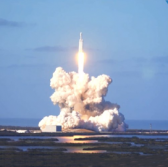 SpaceX’s Falcon Heavy rocket took off Tuesday at 3:45 p.m. Eastern time from a launch pad at NASA’s Kennedy Space Center in Florida as part of its inaugural test flight, Reuters reported Tuesday.
SpaceX’s Falcon Heavy rocket took off Tuesday at 3:45 p.m. Eastern time from a launch pad at NASA’s Kennedy Space Center in Florida as part of its inaugural test flight, Reuters reported Tuesday.
The space vehicle has 27 engines that generated at least 5 million pounds of thrust during takeoff.
The rocket’s two side boosters separated from the central booster within three minutes and performed touchdowns on landing pads at Cape Canaveral Air Force Station in Florida eight minutes after liftoff.
The central booster returned to Earth and traveled at approximately 300 miles per hour before it splashed down into the Atlantic.
Falcon Heavy’s upper stage and its Tesla Roadster car payload would perform a “cruise†phase to high Earth orbit for six hours.
“Exceeded Mars orbit and kept going to the Asteroid Belt,†CEO Elon Musk said of the upper stage in a Twitter post late Tuesday.
Falcon Heavy is built to carry up to 70 tons into low-Earth orbit for approximately 90 million per launch, the report added.
The rocket launch came days after SpaceX received a license from the Federal Aviation Administration for Falcon Heavy’s maiden flight.
TechCrunch also reported that Musk said the company will now focus on the development of its BFR rocket following the inaugural launch of Falcon Heavy.
He noted that BFR could be ready for a “full scale test†in the next three to four years and perform “short hopper flights with the spaceship partâ€Â by 2019.




